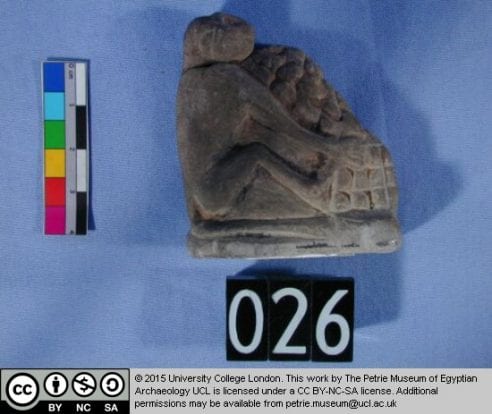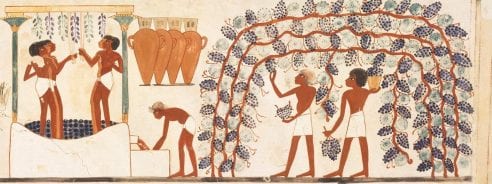A Fine Vintage: Grapes and Wine in Ancient Egypt
By Hannah L Wills, on 20 March 2018
Some of the best conversations I have with visitors in the UCL museums start with the question ‘what’s that?’. A couple of weeks ago, I was asked about an object by a visitor to the Petrie Museum of Egyptian Archaeology, as we stood in front of a case containing an array of small objects. The artefact in question was an oval-shaped sculpture with a point at one end, covered on its surface with a pattern of bubble-like protrusions, made from the pale blue ceramic faience. The case contained a number of similarly shaped objects, and a fired clay mould bearing similar bubble-like impressions.

UC795 and UC800, sculptures found in Amarna, Dynasty 18 (1549 BC – 1292 BC). Image credit: Petrie Museum.

UC1700, fired clay mould used in producing faience sculptures similar to those pictured above. Amarna, Late Dynasty 18. Image credit: Petrie Museum.
After looking them up on the museum’s online catalogue, we discovered that these small objects were depictions of bunches of grapes, produced using moulds like the one displayed in the case. Grape bunches can be found in a variety of objects in the Petrie Museum, in small sculptures like the ones above, and as part of other artefacts. One of the museum’s faience bead necklaces, likely worn by Tutankhamen’s father and described in a recent blog post, features no less than 83 small bunches of grapes among its beads. Other objects in the museum’s catalogue include fragments of plaster featuring painted designs that incorporate bunches of grapes and vines, from the same location and time period as both the grape sculptures and the bead necklace. My favourite grape-related object is a painted limestone statuette of a monkey, depicted happily devouring an enormous bunch of grapes.

UC1957, reconstructed bead necklace made from faience. The necklace features 83 bunches of grapes, and a variety of other forms, including petals, dates, mandrakes and palm-leaves. Amarna, Late Dynasty 18. Image credit: Petrie Museum.

UC026, painted limestone statuette of a monkey eating a bunch of grapes. Amarna, period of Akhenaten. Image credit: Petrie Museum.
Grape clusters like the sculptures above have been found during excavations at a number of New Kingdom sites in Egypt.[i] It has been suggested that grapes were seen as a symbol of royalty, with painted depictions of the fruits often used to decorate royal thrones and garden shrines.[ii] Grapes and vines, and the process of winemaking, also appear on the walls of New Kingdom tombs.[iii] In ancient Egypt, it was mainly the upper classes and royal families who consumed wine. It was also used as an offering to the gods by pharaohs and priests, as seen in depictions in temples from the New Kingdom period up to Greco-Roman times.[iv] As Anna Garnett, curator of the Petrie Museum, has noted, wine was stored in pottery vessels, known as amphorae (pictured below), and was often labelled with the wine’s location of origin and year of production, just as producers do today.[v]

Detail from facsimile reproduction of a wall mural in the tomb of Nakht at Thebes, ca. 1425–1350 BC, Dynasty 18. This fragment depicts the process of wine making. Norman de Garis Davies (1865–1941), Nakht and Family Fishing and Fowling, Tomb of Nakht, tempera on paper. Image credit: Wikimedia Commons.

UC32931, shard of an amphora featuring the text ‘Year 17, sweet wine of the domain of Sehetep-A[ten]’, Amarna, Late Dynasty 18. Image credit: Petrie Museum.
Maria Rosa Gausch Jané, a leading expert on wine and viticulture in ancient Egypt, has suggested that grapes were seen as a symbol of resurrection, and may also have been thought to play a role in the transfiguration process undertaken by kings as part of the journey into the afterlife.[vi] Supplies of red and white wine have been found in the burial chamber of Tutankhamun, symbolically positioned to aid in the various stages of the king’s transition to the afterlife.[vii]
Grapes had great significance in ancient Egyptian culture, in terms of their cultivation, consumption, and symbolism. Next time you visit the Petrie Museum, see how many references to grapes and wine you can spot!
References
[i] ‘Faience grapes from Amarna’, collections database, Y Ganoflan Eifftaidd / Egypt Centre, Swansea, http://www.egypt.swan.ac.uk/the-collection-2/the-collection/w344a/ [Accessed 18 Mar 2018].
[ii] Ibid.
[iii] Ibid.
[iv] Maria Rosa Guasch Jané, ‘The Meaning of Wine in Egyptian Tombs: The Three Amphorae from Tutankhamun’s Burial Chamber’, Antiquity 85 (2011): 851-858, p. 855.
[v] Anna E Garnett, ‘Curating the Petrie Museum: Three Object Stories’, 26 Jul 2017, https://blogs.ucl.ac.uk/museums/2017/07/26/curating-the-petrie-museum-three-object-stories/#more-51323 [Accessed 18 Mar 2018].
[vi] Jané, ‘The Meaning of Wine’, pp. 855-856.
[vii] Ibid, p. 857.
 Close
Close

